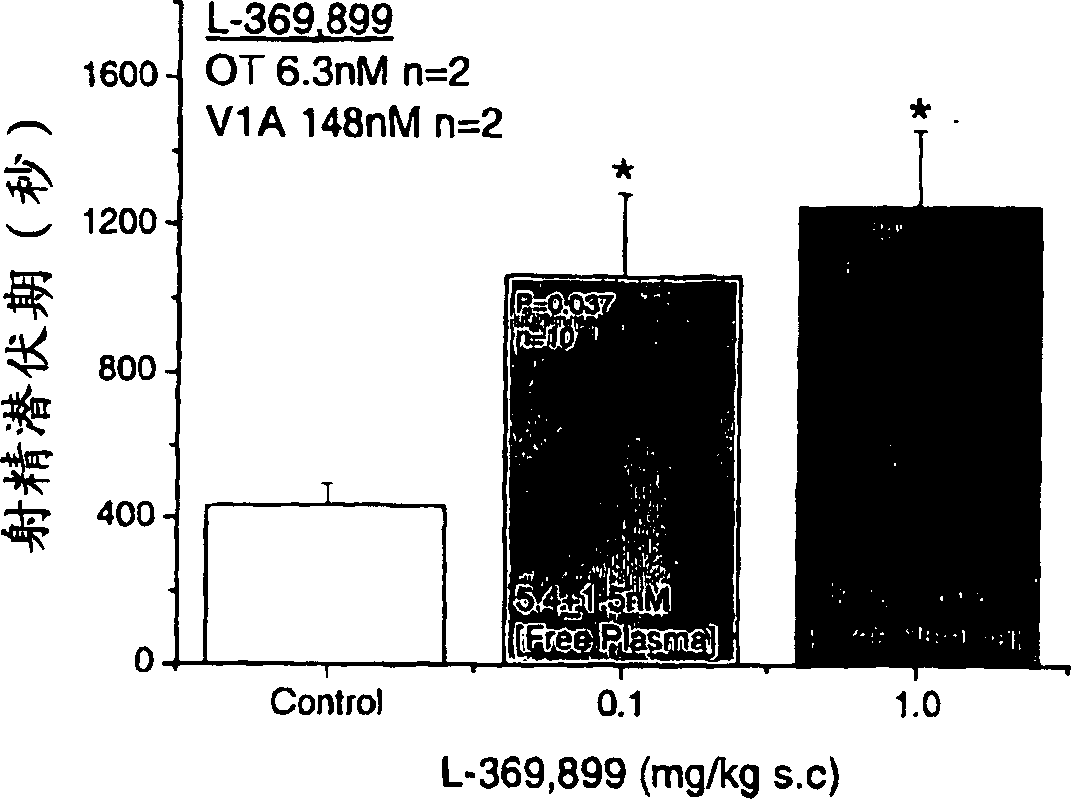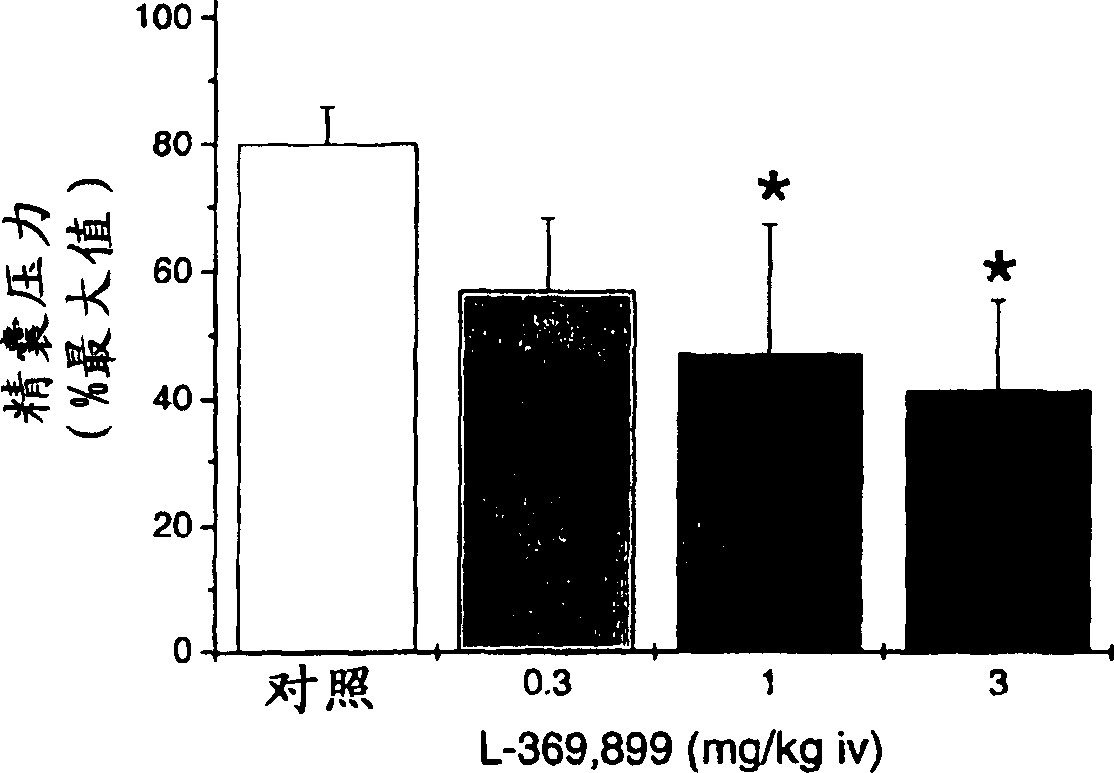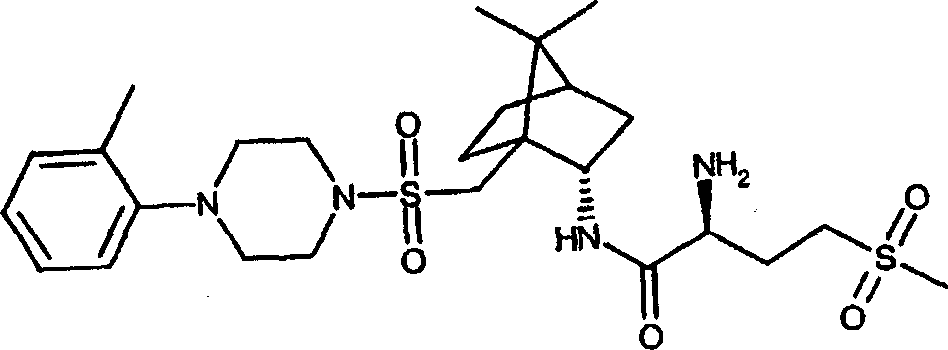Treatment of male sexual dysfunction
A male, selective technology, applied in the field of ejaculation disorders, prevention and/or treatment of male sexual dysfunction, ejaculation disorders, can solve the problem of not very effective, high dropout rate, etc.
- Summary
- Abstract
- Description
- Claims
- Application Information
AI Technical Summary
Problems solved by technology
Method used
Image
Examples
Embodiment 1
[0659] Example 1. In the presence of a selective oxytocin receptor antagonist (L-368,899) ejaculation delay
[0660] The oxytocin receptor antagonist L-368,899 significantly delays parachloramphetamine (PCA)-induced ejaculation in anesthetized rats (0.1-10 mg / kg sc) at oxytocin-selective doses. At 5.4±1.5nM (0.9×Ki OT, see figure 1 At free plasma concentrations of ), ejaculation was delayed by 140% (near maximal effect) - assuming that any activity at this dose was due to oxytocin receptor antagonism.
[0661] Erectile mechanisms were largely unaffected by oxytocin receptor blockade - the cup of the penis and expansion were similar between the control and oxytocin antagonist groups (see Table 1 below). After administration of 1 mg / kg -1 sc dose of L-368,899 (a dose that significantly delayed ejaculation) - 95% of PCA-induced erections resulted in cupping of the penis compared to 94% of the vehicle control group and 61% of PCA-induced erections resulted in The penis unfo...
Embodiment 2
[0665] Example 2. Selective oxytocin antagonist (L-368,899) on seminal vesicles of anesthetized rats effects of stress
[0666] L-368,899 can significantly reduce the increase in seminal vesicle pressure stimulated by splanchnic nerve in anesthetized rats (1-3 mg / kg iv). Contraction of the seminal vesicles is necessary for ejaculation, and delivery of semen into the prostatic portion of the urethra is thought to trigger ejaculation. Oxytocin has a direct contractile effect on mammalian seminal vesicles and may additionally have a neuromodulatory effect affecting sympathetic innervation in ejaculation. In this study, seminal vesicle contraction was reduced by 41% following 1 mg / kg bolus injection (see figure 2 ). Preliminary studies indicated that the achieved concentration of L-368,899 in free plasma following 1.0 mg / kg iv injection was approximately 60 nM - based on literature PK and protein plasma binding.
[0667] The data show that oxytocin is released during visce...
Embodiment 3
[0668] Example 3. Effect of Selective Oxytocin Antagonist (L-368,899) on Mating Behavior in Rats for the influence
[0669] At doses up to 10 mg / kg sc, L-368,899 had no effect on the mating behavior of sexually experienced rats. Mating behavior in rodents is characterized by a series of upper body movements, with and without vaginal penetration (50-80% of the upper body results in penetration [vaginal penetration]) and ejaculation occurs after 6 to 12 thrusts. Each thrust lasts several seconds - it is not possible to quantify the length of penetration, ie the time in the vagina. The effects of L-368,899 were assessed on a number of mating parameters (see above). We focused on coitus efficiency as a measure to profile vaginal penetration.
[0670] L-368,899 had no effect on mating efficiency at any dose tested (0.05-10 mg / kg sc, see Table 2 below). Preliminary pharmacokinetic studies have shown that free plasma concentrations of 4.5 nM and 40 nM are expected to be achiev...
PUM
 Login to View More
Login to View More Abstract
Description
Claims
Application Information
 Login to View More
Login to View More - R&D
- Intellectual Property
- Life Sciences
- Materials
- Tech Scout
- Unparalleled Data Quality
- Higher Quality Content
- 60% Fewer Hallucinations
Browse by: Latest US Patents, China's latest patents, Technical Efficacy Thesaurus, Application Domain, Technology Topic, Popular Technical Reports.
© 2025 PatSnap. All rights reserved.Legal|Privacy policy|Modern Slavery Act Transparency Statement|Sitemap|About US| Contact US: help@patsnap.com



